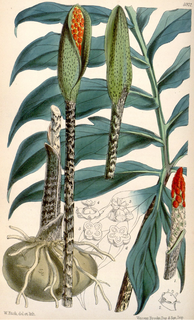
Psidium is a genus of trees and shrubs in the family Myrtaceae. It is native to warmer parts of the Western Hemisphere.

Myrceugenia is a genus of evergreen woody flowering trees and shrubs belonging to the myrtle family, Myrtaceae, first described as a genus in 1855. The genus is native to South America from central Brazil to southern Chile. It is closely related to the genus Luma; some botanists include Myrceugenia in that genus.

Vriesea is a genus of flowering plants in the botanical family Bromeliaceae, subfamily Tillandsioideae. The genus name is for Willem Hendrik de Vriese, Dutch botanist, physician (1806–1862). Its species are widespread over Mexico, Central America, South America and the West Indies.

Campomanesia is a genus in the family Myrtaceae described as a genus in 1794. It is native to South America and Trinidad.

Marlierea is a genus of flowering plants in the myrtle family, Myrtaceae described as a genus in 1833. It is native to tropical regions of South America, the West Indies, and Costa Rica.

Plinia is a genus of flowering plants in the myrtle family, Myrtaceae described by Linnaeus in 1753. It is native to Central and South America as well as the West Indies.

Canistrum is a genus of plants in the family Bromeliaceae, subfamily Bromelioideae.

Dyckia is a genus of plants in the family Bromeliaceae, subfamily Pitcairnioideae.

Blepharocalyx is a genus of plant in family Myrtaceae first described as a genus in 1854. It is native to South America and the West Indies.
- Blepharocalyx cruckshanksii(Hook. & Arn.) Nied. - Chile
- Blepharocalyx eggersii(Kiaerskou) L.R.Landrum - Lesser Antilles, Venezuela, Guyana, Peru, Brazil
- Blepharocalyx myriophyllus Mattos - Minas Gerais
- Blepharocalyx salicifolius(Kunth.) O.Berg - Brazil, Bolivia, Peru, Ecuador, Paraguay, Uruguay, N Argentina
Calycorectes is a genus of plant in family Myrtaceae first described as a genus in 1856. It is native to South America, southern Mexico, and the Dominican Republic.

Asterostigma is a genus of flowering plants in the family Araceae. It is native to Brazil and Argentina. The leaves are pinnate and the plant is tuberous.
- Asterostigma cryptostylumBogner - Brasília, Goiás, Minas Gerais
- Asterostigma cubense(A.Rich.) K.Krause ex Bogner - São Paulo
- Asterostigma lividum(G.Lodd.) Engl. - southern Brazil; Misiones Province of Argentina
- Asterostigma lombardiiE.G.Gonç. - Minas Gerais, Espírito Santo
- Asterostigma luschnathianumSchott - southern Brazil
- Asterostigma reticulatumE.G.Gonç - southern Brazil
- Asterostigma riedelianum(Schott) Kuntze - eastern Brazil
- Asterostigma tweedieanumSchott - Santa Catarina in southern Brazil
Campovassouria is a genus of flowering plants in the daisy family, Asteraceae.
Symphyopappus is a genus of South American plants in the boneset tribe within the sunflower family.
Graphistylis is a genus of Brazilian flowering plants in the daisy family.

Aechmea coelestis is a species in the genus Aechmea. This is a species that is native to southeastern Brazil from Espírito Santo to Santa Catarina.
The Brazilian municipal elections of 2012 took place on October 7 and on October 28. Over 138 million voters chose mayors, deputy mayors and city councillors for the 5,568 municipalities of Brazil. These were the first elections in which the recently registered parties Partido Pátria Livre (PPL) and Partido Social Democrático (PSD) participated; they were both recognized by the Superior Electoral Court in 2011. Political parties whose candidates wished to run for the 2012 elections had to be registered at the TSE for at least one year before the election date, while candidates also had to be affiliated to a party for the same period of time. Conventions for the selection of candidates within the parties occurred between 10 and 30 June, while the registry of candidates and alliances with the Regional Electoral Courts took place until July 5. Electoral campaign was authorized from the moment a candidacy had been registered. The free electoral program – two daily slots on free-to-air TV and radio for political advertising paid by the Electoral Justice fund – ran weekdays from 21 August until 4 October. According to the current Brazilian electoral law, the two-round system – should the leading candidate receive less than 50% +1 of the votes – is only available for cities with more than 200,000 voters. This includes all state capitals, with the exception of Boa Vista, Roraima and Palmas, Tocantins, plus 59 other municipalities. The free electoral program for the second round ran from 13 October until 26 October.
Saranthe is a genus of plants native to Brazil and Paraguay, described as a genus in 1861.
Calyptrogenia is a genus of flowering plants in the family Myrtaceae first described as a genus in 1941. It is native to two islands in the West Indies: Jamaica and Hispaniola.
- Calyptrogenia bifloraAlain - Sierra Prieta in Dominican Republic
- Calyptrogenia bracteosa(Urb.) Burret - Massif de la Hotte in Haiti
- Calyptrogenia cuspidataAlain - southwestern Dominican Republic
- Calyptrogenia ekmanii(Urb.) Burret - Massif de la Hotte in Haiti, northeastern Jamaica
- Calyptrogenia grandifloraBurret - Haiti, Dominican Republic
- Calyptrogenia jeremiensis(Urb. & Ekman) Burret - Massif de la Hotte in Haiti, northwestern Jamaica

Siphoneugena is a genus of the botanical family Myrtaceae, first described as a genus in 1856. It is native to Central and South America as well as the West Indies.











